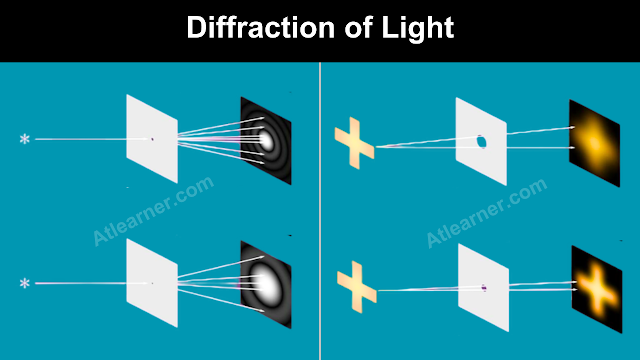What is Diffraction of Light?
Definition: Diffraction of light refers to the phenomenon where light waves deviate or bend from their expected straight-line path as they encounter an obstacle or pass through a narrow aperture.
As we know from common experience, sound waves can bend around an obstacle or pass through a hole and spread around. It has been observed that the same phenomenon occurs in the case of light waves.
To better understand this, consider a simple experiment. Suppose a thin sheet of tin is placed in the sunlight and its shadow is cast on a wall. We know that sunlight coming from far away can be considered as parallel rays and according to geometrical optics, light travels along straight lines.
So the thin tin sheet should get a clear shade. But if you look closely at the shadow, you will see that the edges of the shadow are not very clear. From this fact, it can be concluded that the light ray is bent when it approaches the edge of the sheet.
Experiments have shown that the direction of motion of any wave changes when approaching an obstacle or passing through a hole. Since light is a wave, light also undergoes diffraction.
In the image below you can see an image of the plus sign. When light passes through a big hole, the plus image appears blurry and spread out. But when light goes through a narrow hole, it creates a sharper image of the plus sign. This happens because narrow holes bend the light more, like a lens, making a clearer image. So, remember, big holes make fuzzy images and narrow holes make clear ones!
Several important conclusions can be drawn from the phenomenon of diffraction of light:
Light Propagates as a Wave: Light, like other waves, travels in a wave-like manner, demonstrating that it is not limited to behaving as a straight-line ray.
Aperture Size Matters: When the size of an aperture is much larger than the wavelength of light, the diffraction effects are not easily noticeable. In such cases, light appears to travel in straight lines, aligning with geometric optics.
Sharp Edges Enhance Diffraction: The phenomenon of diffraction is more pronounced when the edges of the obstacle or aperture are sharp, making the bending of light more noticeable.
Nature of Light Waves: While diffraction confirms the wave nature of light, it does not provide insights into whether light waves are longitudinal or transverse.
Wavelength Dependency: Longer wavelengths, such as those of sound waves and radio waves, exhibit relatively more pronounced diffraction effects.
Classification of Diffraction
Diffraction phenomena of light waves can be broadly classified into two categories: Fresnel diffraction and Fraunhofer diffraction.
1. Fresnel Diffraction:
Fresnel diffraction occurs when the light source, screen, or both are at a finite distance from the aperture. The wavefront incident on the screen is round or beak-shaped. Examples include sharp-edged obstacles, narrow wires, small round holes, and narrow slits cause this kind of diffraction.
2. Fraunhofer Diffraction:
Fraunhofer Diffraction occurs when both the light source and the screen are at an infinite distance from the aperture. The wavefront incident on the screen is flat. Examples include single slits, double slits, and diffraction gratings cause this kind of diffraction.
Comparison between interference and diffraction of light
Both interference and diffraction of light are phenomena caused by the overlap or superposition of light waves. At the root of the formation of diffraction fringes is the interference of waves.
However, there are some fundamental differences between diffraction and ordinary interference. The differences are as follows:
Interference:
1. Superposition of light waves emitted from two coherent sources causes diffraction.
2 Widths of the interference fringe are generally equal.
3. The intensity of bright bands in fringes is uniform.
4. Dark bands in interference fringes are completely dark.
Diffraction:
1. Superposition of secondary waves coming from different points of the same wavefront causes diffraction.
2 Widths of the diffraction fringe are not equal.
3. The intensity of bright bands in diffraction fringes is non-uniform.
4. Dark bands in diffraction fringes are partially dark, not completely dark.
Applications of Diffraction
Diffraction of light has several practical applications in various fields, including:
Spectroscopy: Diffraction gratings are used to disperse light into its component wavelengths, allowing scientists to analyze the composition of substances and celestial objects.
Microscopy: Diffraction plays a crucial role in optical microscopy techniques, enabling the observation of small structures and details.
Laser Technology: Diffraction is employed in the creation of laser beams, beam splitters, and optical elements used in laser systems.
Holography: The principles of diffraction are central to the creation and viewing of holograms, providing a 3D visual experience.


Post a Comment (0)